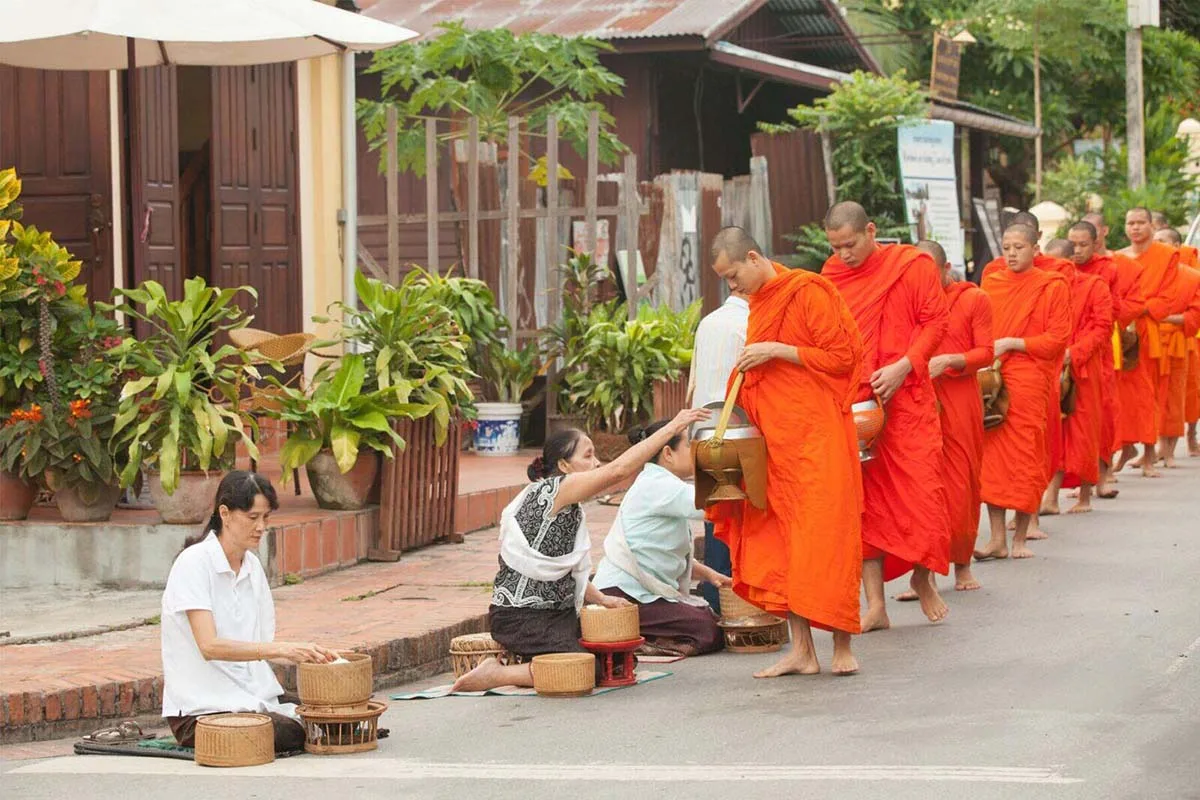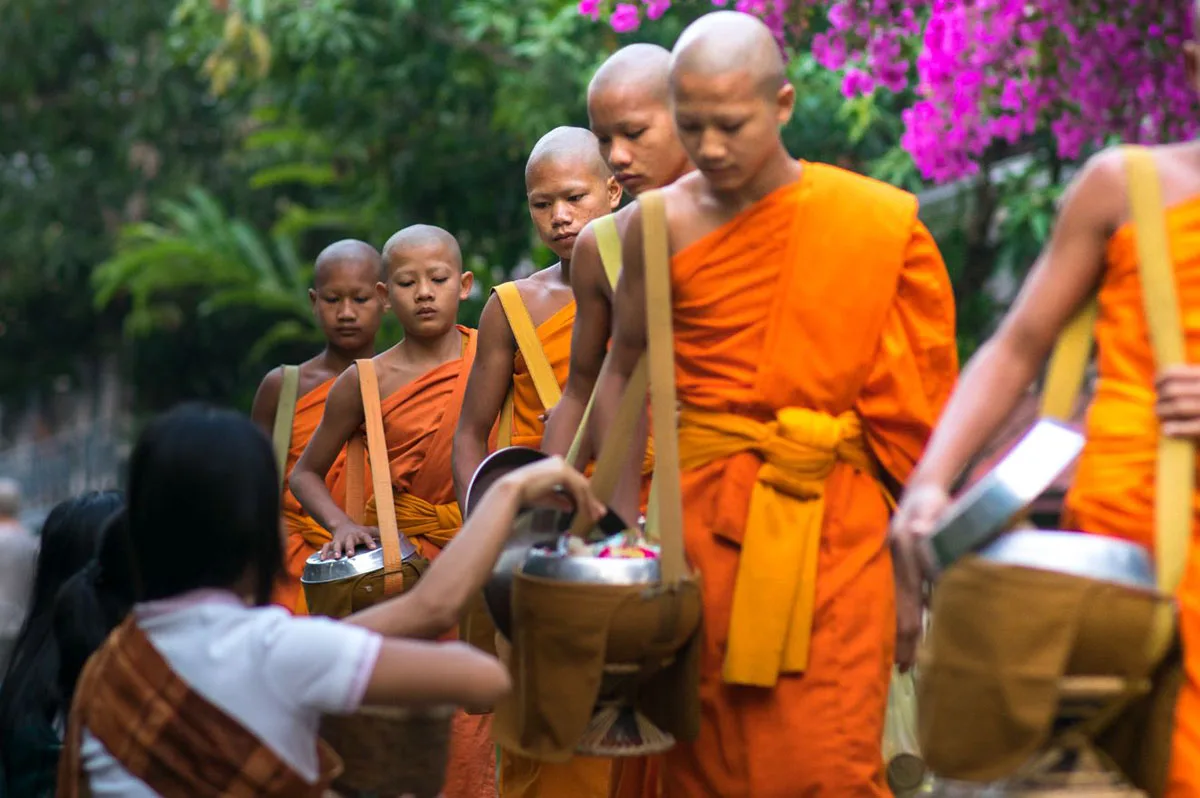Introduction: The Calm Before Sunrise
When the rest of Thailand still snoozes under the soft hum of morning fans, saffron robes begin to move silently through village streets. Bowls in hand, barefoot monks walk in single file while locals kneel respectfully, offering sticky rice, fruit, and warm smiles.
This serene ritual is called Tak Bat (ตักบาตร) — one of the most spiritually powerful and visually poetic scenes in Thai Buddhism.
Whether you’ve seen it in Chiang Mai’s Old City or along the Mekong in Nong Khai, Tak Bat is more than just a morning routine — it’s a living act of compassion, humility, and community that has united Thai society for centuries.
What Does Tak Bat Mean?
The term Tak Bat literally means “to place food into a bowl.”
It refers to the daily ritual where laypeople (ordinary Buddhists) offer alms — usually food — to monks, who rely entirely on these offerings for their sustenance.
It’s not charity in the Western sense. Instead, it’s a two-way exchange of merit and mindfulness:
-
Laypeople earn spiritual merit (tham bun) by giving with a pure heart.
-
Monks, in turn, offer blessings and serve as living reminders of Buddhist teachings.
🧘♂️ It’s not about feeding monks — it’s about feeding your soul.

The Spiritual Meaning Behind Tak Bat
In Thai Theravada Buddhism, Tak Bat represents the interdependence between monks and laypeople — a core pillar of Buddhist society.
Monks dedicate their lives to spiritual practice and detachment from material needs, while laypeople support them physically through almsgiving.
This humble ritual teaches three timeless lessons:
-
Generosity (Dana): Giving selflessly without expecting anything in return.
-
Mindfulness (Sati): Being fully present during the act of giving.
-
Humility (Vinanaya): Respecting simplicity and spiritual discipline.
Each offering becomes a small reminder that happiness grows when shared, not when stored.
How Tak Bat Works: Step by Step
If you’ve never witnessed Tak Bat, here’s how it unfolds — gently, respectfully, and always before the morning coffee rush.
-
Before Dawn:
Monks leave the temple (wat) barefoot, walking silently through the streets with their alms bowls (bat). -
The Offerings:
Locals kneel or sit on low stools along the route. They place food — rice, fruit, or curries — gently into each bowl, avoiding direct hand contact. -
The Blessing:
Once the offerings are made, monks chant short blessings in Pali, radiating goodwill and gratitude. -
The Return:
Monks return to the temple to share and consume their single daily meal before noon — a rule explained in more detail in our article Life of Theravada Monks in Thailand.
🍚 Funny fact: A monk’s breakfast might be more varied than a hotel buffet — all thanks to generous neighbors and curious tourists!
Where to Experience Tak Bat in Thailand
You can witness Tak Bat in almost every Thai town, but a few places make it truly unforgettable:
-
Chiang Mai Old City:
Monks walk past ancient temples as tourists quietly observe. -
Luang Prabang (near Thai border):
Technically Laos, but spiritually close — one of Southeast Asia’s most famous almsgiving scenes. -
Bangkok:
Early mornings near Wat Benchamabophit or Wat Saket reveal the beauty of quiet devotion amid the chaos of the capital. -
Rural Villages:
The most authentic Tak Bat happens far from cameras — where farmers and monks know each other by name.
How to Participate Respectfully
If you’d like to join Tak Bat as a foreign visitor, follow these simple yet meaningful guidelines:
-
Dress Modestly:
Cover shoulders and knees. White clothing is most respectful. -
Act Quietly:
No loud talking, laughing, or selfie sticks. -
Prepare Food Thoughtfully:
Fresh rice or fruit — not snacks or money. -
Use Both Hands:
Offer food with both hands as a sign of respect. -
Kneel or Sit Low:
Standing above a monk is considered disrespectful. -
No Direct Contact:
Avoid touching monks or their bowls, especially if you’re a woman. -
Receive the Blessing Silently:
Smile, bow slightly, and carry the calm feeling with you for the rest of the day.
🙏 Lesser-known fact: In some regions, locals also offer daily essentials like soap or toothpaste — even monks need clean teeth for chanting.
Tak Bat in the Modern World
In today’s digital age, Tak Bat faces both challenges and reinventions.
Tourism has brought visibility but also misunderstanding — some treat it like a photo opportunity rather than a sacred act.
Many temples, such as Wat Phra Singh in Chiang Mai, have created special areas for tourists to observe or participate respectfully.
Still, the essence remains the same: pure intention matters more than perfect execution.
Modern Thais also perform Tak Bat on important holidays and festivals, like Makha Bucha or Visakha Bucha, which you can find in our
Thailand Festivals Calendar
Why Tak Bat Still Matters
Tak Bat might look simple — a bowl, some rice, and quiet footsteps. But beneath that simplicity lies a powerful message:
“The smallest act of giving can bring the greatest inner peace.”
It’s a moment when monks and laypeople step out of their daily roles and connect on a human, spiritual level.
In a world obsessed with noise and speed, Tak Bat is Thailand’s daily reminder to slow down, breathe, and give.
Related Reading
FAQ – Tak Bat in Thailand
Yes, respectfully! Dress properly, stay quiet, and follow the guidance of locals or temple staff.
It’s part of their discipline — to reduce attachment to material comfort and focus on spiritual development.
The concept is shared, but rituals vary slightly. In Laos, Cambodia, and Myanmar, similar almsgiving traditions exist with local customs.
Conclusion: A Morning Worth Waking Up For
Tak Bat is more than an ancient ritual — it’s a spiritual bridge between past and present, between those who give and those who dedicate their lives to wisdom.
Whether you participate or simply observe, witnessing Tak Bat in Thailand is an unforgettable experience of serenity, generosity, and quiet joy.
Next time you wake before dawn in Thailand, listen closely.
You might just hear the soft rustle of robes — and a timeless whisper reminding you that peace begins with giving.
Your Turn
Have you ever joined a Tak Bat ceremony?
Share your experience or impressions in the comments — and if you loved learning about this Thai tradition, spread the good karma by sharing this article!
#ThaiCulture #BuddhistAlmsgiving #TakBat #ThailandTravel #SpiritualThailand #AlmsGivingGuide
